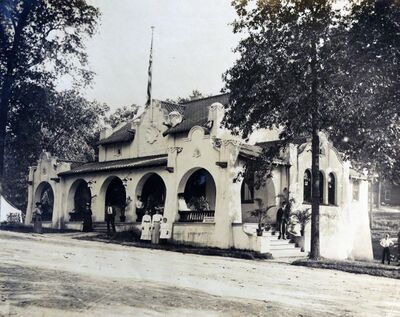New Mexico
 | |
| Location | Plateau of States |
|---|---|
| Construction | |
| Construction Cost | $6,053 ($182,554 in 2021) |
| Architecture | |
| Architect | T. H. Rapp, of Las Vegas |
| Dimensions | 40' x 62' |
The design of the New Mexico territory building on the Plateau of States was Spanish Renaissance, a type of architecture common in the far Southwest.
Etymology
Another interesting feature of the exhibit is the oldest bell In America, the "Maria Josefa," made in Spain in 1355, nearly a century and a half before the discovery of America. It was taken to New Mexico In the sixteenth century and did service for many years in one of the old mission churches. Beautiful rugs made by the Navajo Indians of New Mexico, old pottery, handsomely carved and painted, beautiful drawn work and Indian bead work, arrow heads, etc., comprising the interesting contents of the building. The white duck coat worn by Aguinaldo when captured by Funston was on exhibition in the New Mexico building.
The room to the right is called the "Governor's Room," and in it are portraits of Governor Otero and Mrs. Otero. That shield with the Filipino arms in miniature, was loaned by the Governor's wife. It is in the Governor's room that the Kingsbury piano was placed. The furniture there is of rine old mahogany, and the upholstering in Spanish leather. About the moulding, above the doors and windows, are paintings from monasteries five centuries old. Those Navajo blankets in the reception room are very rare and expensive, as is that squaw cloth over the entrance to the offices.
Before the Fair
Description
The surrounding grounds were laid out in typical gardens, splendid specimens of cacti were shown and many of the most beautiful flowers of New Mexico embellished the place.
At the entrances are great urns decorated with drawings by Cochite or Zuni.
Inside the reception room, a mound was formed of old monastery bells, one of which is five hundred and forty years old, and each bears an inscription. A famed filigree table, the property of the Woman's Board of Trade and Library Association of Santa Fa, the oldest city in the United States, is made of silver with elaborate decorations of gold, turquoise and garnet. The corners and side were made of onyx. The gold and silver filigree work on the table is magnificent. The top is the shape of a Maltese cross. In the precious metals are pictures of a Mission Church, Fort Marcy, and the old Spanish Governor's house in which Lew Wallace wrote Ben-Hur. The coat-of-arms of the territory, in the center, is surrounded by garnets. The table was kept under a glass case. It was very delicate, and cost more than $3,000 ($90,478 in 2021), so it was kept secure from prying fingers.
Another interesting feature of the exhibit is the oldest bell In America, the "Maria Josefa," made in Spain in 1355, nearly a century and a half before the discovery of America. It was taken to New Mexico In the sixteenth century and did service for many years in one of the old mission churches. Although this was advertised as fact at the Fair, later research concluded the bell was most likely forged in New Mexico around 1855.
The room to the right was called the "Governor's Room," and in it are portraits of Governor Otero and Mrs. Otero. A shield with the Filipino arms in miniature, was loaned by the Governor's wife. The furniture is of fine old mahogany, upholstered in Spanish leather. It was in the Governor's room that the Kingsbury piano was placed.
About the molding, above the doors and windows, are paintings from monasteries five centuries old.
The white duck coat worn by Aguinaldo when captured by Funston (during the war in the Philippines) was on exhibition in the New Mexico building.
The superior products shown in New Mexico's agricultural and horticultural exhibits demonstrated that the very best results and most perfect development in fruits and farm products are obtained by irrigation and sunny skies. The fruits, grains, vegetables, and other products of the soil shown were well-received.
New Mexico had exhibits in the Palaces of Education, Mines and Metallurgy (including: coal, iron, zinc, lead, copper, silver, gold, mica, gypsum, salt, sulfur, asbestos, onyx and building stones), Agriculture (irrigation), and Horticulture. The state's principal exhibit was in the Mines and Metallurgy (a working exhibit in exclusive turquoise mining, and lapidary).
Their impressive educational exhibit might have quickened the territory's statehood (In 1912).
After the Fair
See also
Notes
References
External links
https://www.elpalacio.org/2019/11/ringing-false-ringing-true/ https://armyhistory.org/a-desperate-undertaking-funston-captures-aguinaldo/#:~:text=Until%20Aguinaldo%20and%20his%20officers,came%20on%208%20February%201901.
